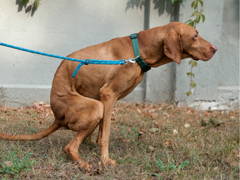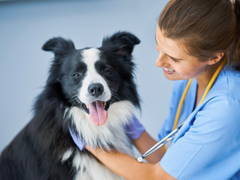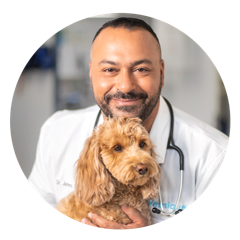Does Your Pet Need Advanced Anal Gland Support?
Are you regularly visiting the vet to have your pet’s anal glands expressed? Taking your pet to the vet can be stressful for them and you, but in the case of anal gland health, it turns out there’s more you can do for them at home.
If you’re unsure about the severity of your pet’s anal gland issues, a combination of home care and advice from your vet can make future vet expenses less likely. Your pet’s anal gland health history will play a part–and so can their supplements. We’re discussing how to identify advanced anal gland symptoms, what recurrence can look like, and how to best support your pet’s anal gland function at home.
How Healthy Anal Glands Function
Functioning anal glands can easily go unnoticed–meaning you won’t really notice they’re there until there’s a problem. Still, when your pet’s anal glands are healthy, you should be able to count on a few predictable patterns:
1. Regular bowel movements
One of the main causes of anal gland issues is a change in bowel habits, which can happen as a result of illness, parasites, change in diet, or stress. Promoting regularity should include supplying your pet with a blend of soluble and insoluble fiber, clean water, regular exercise, and a balanced diet.Did you know? If your pet is sick, changes in bowel habits–diarrhea, constipation–can come with the territory. To keep your pet comfortable (and regular) be sure to supply fiber, probiotics, and other gut-friendly supplements to help get their tummy back to normal.
2. Healthy stools
The best way to support anal gland health is to ensure your dog is producing healthy stools. What does healthy stool look like? Firm, bulky stool that’s elongated–not pebbled–in shape. Think of it this way: if your dog’s stool mimics the tubular shape of their digestive tract, that’s generally a good sign!
3. Stool with an oily film
The oily substance inside a dog’s anal glands should, ideally, be expressed with every bowel movement. Firm, bulky stools that move through the rectum should naturally apply pressure on both sides of the anal canal. This pressure naturally expresses the anal glands–and releases the oily substance through your dog’s anal sphincter (with the passing stool).
Did you know? You may or may not notice this substance as a slight layer of mucous around your dog’s stool. A healthy color for anal gland excretions is a clear or pale yellow-brown. Don’t worry about that smell–anal gland excretions are known for their unpleasant ‘fishy’ odor.

Signs That Your Pet Needs Anal Gland Support
If your dog’s anal glands aren’t functioning properly, there will be clues. Common signs of a disruption in a dog’s anal glands are:
- Scooting their bottom across textured surfaces, like carpet or grass
- Licking their rear end, or at the base of their tail
- Constipation, straining, or painful defecation
For most dogs, using a vet-formulated supplement rich in fiber and other GI-supportive ingredients can help get anal gland health on track. An abrupt increase in fiber can cause adverse effects for your pet, so it’s important to start any new fiber supplement gradually. These temporary effects could include diarrhea, bloating, and gas, but should improve with continued use–if not, contact your vet for guidance.
When it comes to anal gland supplements, starting with half the recommended amount for the first week can help your pet’s digestive system adjust–and consistency is key. Pay close attention to the directions on your supplement’s packaging, as most anal gland supplements require daily use for an extended period in order to fully benefit your pet.

Severe Anal Gland Issues: When Your Dog is Still Scooting
If your dog isn’t new to scooting, you may be wondering if their case qualifies for advanced or extra-strength anal gland support. So, what are the signs indicating a more advanced case of anal gland disruption? These will be the biggest red flags to look out for:
- Your dog requires frequent anal gland expressing (more than 1-2 per month).
- Your dog is prone to frequent anal gland infections or abscesses, during which the anal glands develop an infection that fills with puss. Absescess will be painful, and can cause anal gland impaction.
- Your dog has previously taken a fiber supplement or anal gland supplement and seen positive results–but scooting, licking, and constipation eventually returned, and seem to be more severe or persistent than before.
- You’ve just finished giving your dog an anal gland supplement for 3-5 weeks or as directed, but they still need additional support.
-
Signs of anal leakage and related odor seem to be constant, even between bowel movements. This occurs when glands become irritated and hypersecrete, which can be very frustrating for the pet parent, as it can cause a foul smell to linger around the house.
-
You suspect an obstruction in your dog’s anal glands. This will occur when they can no longer empty their glands on their own, and need medical attention–in other words, a trip to the vet for manual expression. Once the glands become impacted, the material inside becomes trapped, which will typically lead to an infection and painful abscess.
-
Your dog’s sphincter appears red or swollen, indicating a potential anal gland infection. The area will be painful for your dog, and may be tender to the touch.
-
Your veterinarian suspects that your pet is susceptible to impacted anal glands, a situation where the ducts that empty the glands become occluded (blocked) and cannot release the fluid.
Causes of Advanced Anal Gland Issues
- Poor anatomy that doesn't allow the glands to empty properly (too low or located too far internally). This can be common in smaller breeds like Basset Hounds, Beagles, and Chihuahuas.
- Digestive issues that lead to chronic soft stool, diarrhea, or colitis.
- Severe allergies (atopy), including environmental allergies from dampness, dust mites, and mold. Pets with severe reactions to irritants like soaps, detergents, and shampoos can also be more prone to anal gland issues.
- Latrogenic factors, which are caused by medical treatment and/or examination. If the glands are expressed too often, it can further irritate the glands and surrounding tissue or cause them to lose their tone, which can further worsen the symptoms and increase risk for long-term damage.

Treatment Options for Advanced Anal Gland Support
- Express the glands as needed if they are full, impacted, or otherwise unable to express on their own. Your veterinarian and their team are best qualified to do this at their clinic, especially if your dog is experiencing pain or tenderness in their rear end.
- Work with your veterinarian to identify and treat underlying causes, including allergies and digestive issues that could be enabling anal gland symptoms to persist.
- Give your pet daily supplements and maintain a balanced diet for anal gland and digestive health. Fiber, probiotics, and digestive enzymes should all be employed for dogs needing advanced GI support.
- Follow your veterinarian’s advice on when to enlist antibiotics or prescription drugs for your pet, to treat infections and other underlying issues that could be disrupting your dog’s anal gland function.
- Consider surgical treatment to help flush the glands or, in extreme cases, removal of the glands (Anal Sacculectomy) as advised by your vet.
Anal Gland FAQs, Answered By a Veterinarian

Vetnique founder, Dr. James Bascharon, is a veterinarian with extensive experience treating dogs with anal sac disease. He has a few pointers for pet parents supporting their dog’s anal gland health at home:
Yes, the severity of anal gland problems can come and go, and can be influenced by allergies and inflammation that affect the surrounding areas and anal glands themselves.
If it's an ongoing problem that never resolves, they likely have chronic anal gland disease–which is considered severe. If their anal gland issues resolve from time to time, that is certainly a more optimistic situation. If anal gland issues seem to come and go, then identifying the underlying cause(s) can help with prevention in the future.
Yes, definitely. The goal is to maintain optimal digestive health and healthy stools, which can be achieved by using the right supplement for your pet’s unique needs. Taking a proactive and preventative approach is certainly helpful for maintaining anal gland health.





